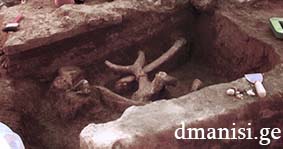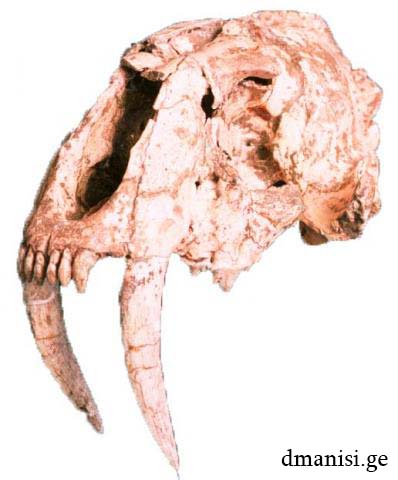Paleolithic Dmanisi
FAUNA

The fossil animals found in Dmanisi are characteristic for the very beginning of the Quaternary period, represent the so called late Villafranchian faunal assemblage and indicate an age of approximately 1.8-1.7 million years.
Animal world of Dmanisi was strikingly different from the one that is present today in the Caucasus. Biodiversity was very high at that times: apart of homo 45 vertebrate species (1 amphibian, 3 reptiles, 3 birds and 38 mammals) are known from Dmanisi. Among them deers and horses are especially abundant. Carnivores are noticeably diverse (14 speceis), as well as bovids - a group uniting antelopes, goats, sheep and cattle (7 species). Many of the Dmanisi species represent groups which are either entirely extinct such as saber-tooth cats (Homotherium and Megnatereon) [fig. below to the right] or are not present in Eurasia any more, e.g. Palaeotragus – a short neck giraffe and giant ostrich; or simply it’s hard to fit into the present-day landscape such as elephants, rhinos, giant cheetahs etc.

It is very important to comment on the rodents of the Dmanisi mammalians. These animals are very adaptive to any climatic changes; they differ from the rest of the animals with a constant, stabile contact with the physical landscape and geographical environment. They are very reliable indicators for reconstructing the paleoclimate and paleoecology of the period. Rodents multiply very fast, promoting important genetic recombinations, which is a basis of fast evolution. In the Dmanisi faunal list, we can already observe a part of the historical evolution of the voles polonicus (leaving 2.1-2.5 Ma in other sites of Georgia) developed into – pliocaenicus- ostramosensis (1.77Ma) found in Dmanisi.
